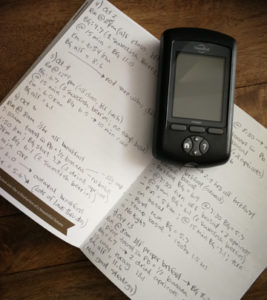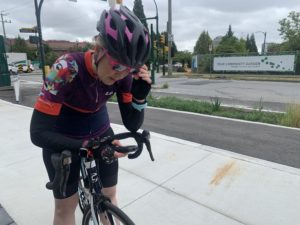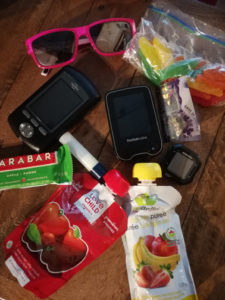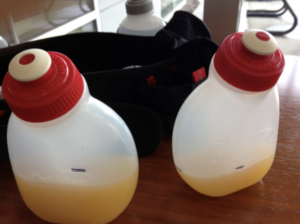T1D and sport is 100% doable and 100% recommended. However, as my last blog post noted, it can be quite challenging at times.
One of the biggest challenges is the fact that no matter how much preparation we do, we can never guarantee reproducibility with T1D and sport.
But that doesn’t mean that we should stop trying.
Nope.
I am a firm believer of taking those challenges and breaking them down in order to find solutions to best not experience them again.
So, let’s do that.
My main struggles during that bike ride were insufficient preparation, temperature, technology, nutrition and hydration.
Let’s break that all down with a T1D sport lens.

Preparation:
People with type-1 diabetes rely on outside insulin to manage blood sugar. We don’t have on-off mechanisms within our bodies to turn the insulin up or down when needed. Rather, we have to manually adjust our insulin levels by injections or insulin pump.
That’s why preparation for T1D and sport is so key.
The general guidelines for T1D and sport (endurance) recommend to:
- Reduce mealtime insulin by 25-75% if within 1.5-3 hours of exercise
- For insulin pumps, reduce basal insulin by 50-80% up to 90 minutes before starting exercise and continue throughout the exercise
- Consume 10-90 grams of carbohydrates per hour. This range depends on duration, intensity, blood sugars, and circulating insulin
Keep in mind, these are general recommendations; they are not specific to a person. That means, trial and error is a necessary for optimal outcomes.
Strategy:
- Keep a journal. Document blood sugars before, during, and after, as well as foods consumed, and timing of foods consumed, and any insulin adjustments made. This will help you keep track of your trial and error efforts, and make adjustments as needed.

Temperature:
Both hot and cold temperatures can impact performance and blood sugars.
For blood sugars, mostly it comes back to the effects of extreme temperature on insulin.
Opened insulin can be stored at room temperature, between 15-25 degrees celsius. When a person has that insulin on their body, ie. via an insulin pump, and the temperatures are significantly greater or lower than that, we run the risk of degrading our insulin and making it useless.
The result: high blood sugars.
Strategy – Temperature:
- Try not to wear your insulin pump in a location that’s exposed to the heat. On the bike, those spots for me would be my arms and back.
- For those with pens or additional insulin vials on their person, storing the insulin in a stainless steel insulated mug can help with temperature control, as can Frio packs.
Excessive heat can also increase risk for low blood sugars. This is because of blood vessel dilation, which increases the rate of insulin absorption. Combine that with the effects of exercise doing the same, and it’s a recipe for hypoglycaemia.
Strategy:
- Try not to wear your insulin pump or inject insulin near the location of the muscles that will be most used during that exercise. For running and cycling, I would avoid the legs.
Technology:
T1D technology is great, but sometimes old-school ways can be the better way.
Technology is not perfect; it has faults. And CGMs with exercise is one area of limitation.
Changes that occur in the the body during exercise – such as increased blood flow, body temperature, and body acidity – can affect the accuracy of sensor readings. When our blood sugars are rapidly changing, CGM sensors can’t keep up and a delay in accuracy of up 12-24 minutes can occur.
What we’re seeing on the sensor is not necessarily what our blood sugars are in that moment.
And that means that we could potentially be treating for lows and highs that aren’t actually present or that have already resolved.
Strategy:
- I don’t have a one-size fits all strategy for technology. This is where trial and error comes to play. Understanding your body with T1D and sport, and understanding your sensor at the time with exercise is important.
- Recognizing your comfort level is important also. I generally take my phone for the Dexcom, but also a meter and test strips if I’m going to be exercising for longer than 60 minutes. I don’t always use the meter, but in a pinch it’s my backup. And that’s my comfort.

Nutrition:
Nutrition during sport is important for both brains and muscles. Without proper food, our minds can become foggy and our muscles fatigued.
Add T1D to that mix, and now nutrition is also a component of blood sugar management.
Without adequate fuel, most importantly simple carbohydrates, we are potentially screwing all of those things up.
But elements of nutrition can also mess us up in the sport realm.
High fibre foods, protein, and fat should not be consumed close to exercise. Optimally, 30-60 minutes beforehand should be free of those components.
That’s because our bodies are super slow to digest these foods. And if they are still sitting in our stomach during exercise, we’re risking feelings of nausea, cramping, diarrhea, and vomiting.
Simple carbs are better choices in that time frame.
Strategy:
- Have a full meal with all the food groups several hours before exercise. Anywhere 2-3 hours beforehand should be okay
- Focus on simple carbs immediately before and during exercise

Hydration:
Did you know that mild to moderate dehydration can increase blood sugars by 3-5.5 mmol/L?
Severe dehydration can increase blood sugars even higher and more rapidly leading to nausea, vomiting, electrolyte and sodium imbalances.
Our bodies are made up of about 60% water. They need fluids!
In addition to impacts on diabetes, dehydration can also impair cognitive function and performance at all levels of sport.
Strategy:
- Carry bottles of a homemade electrolyte drink and sip regularly, ie. every stop light or pause in a game.

Conclusion:
Diabetes is a complex disease, and our bodies are pretty complex too. We need to respect both during exercise.
Resource:
For a downloadable PDF on tips for managing T1D and sport, fill out the form and I’ll send it your way!
[contact-form][contact-field label=”Name” type=”name” required=”true” /][contact-field label=”Email” type=”email” required=”true” /][contact-field label=”Website” type=”url” /][contact-field label=”Message” type=”textarea” /][/contact-form]
